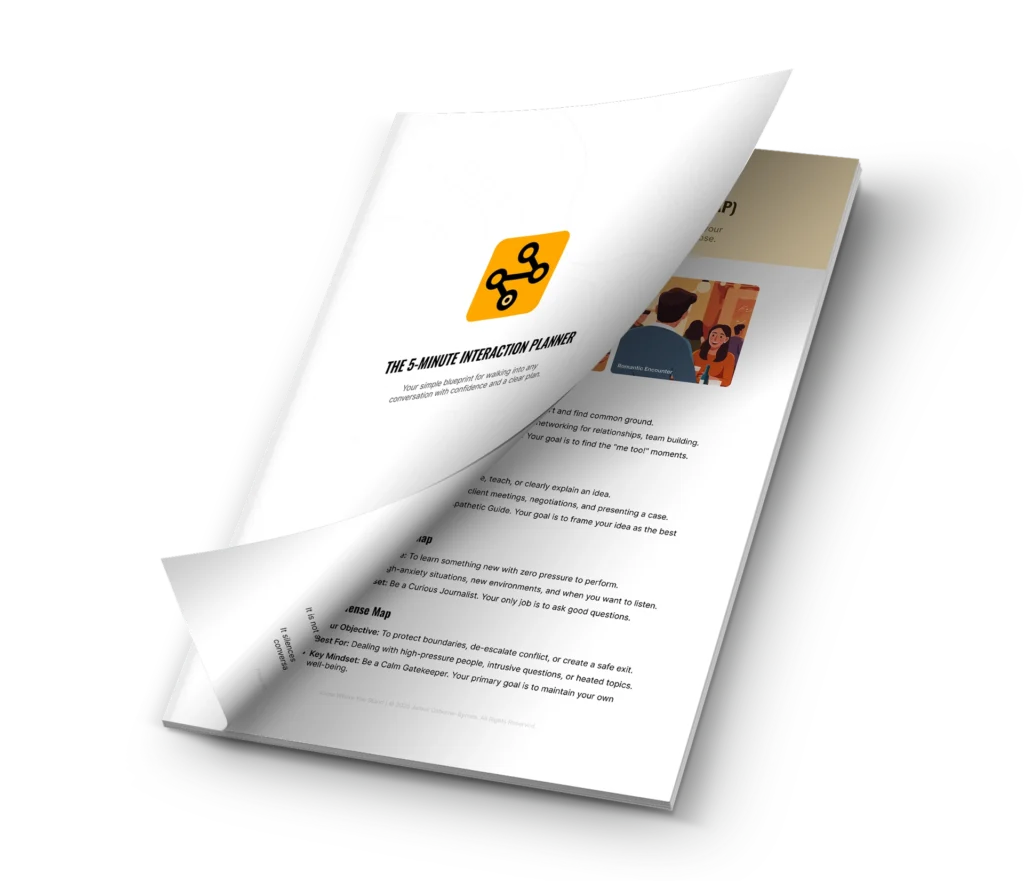You’re in a conversation, someone makes a slightly ambiguous comment, and your mind immediately splits into a dozen branching timelines. “Was that a joke? A subtle jab? A genuine question?” By the time you’ve analyzed every possibility, the moment has passed, leaving you silent and stuck. This experience isn’t a lack of social skill. It is the classic trap of analysis paralysis, especially for those with high situational awareness. To move from passive observer to active participant, you don’t need more observations. You need a better system for acting on them. This guide introduces a practical social decision making framework designed to turn your insights into confident action.
Why intelligent observation leads to conversational gridlock
Getting stuck in your own head isn’t a flaw. It’s a common side effect of a highly analytical mind that needs better direction. Understanding why it happens is the first step toward a solution.
A high sensitivity to social cues and subtle relational dynamics can create an overload of information. You notice the slight shift in tone, the quick glance away, the subtle change in posture. Seeing it all provides many data points, but it’s hard to know which one to act on. This is the heart of the problem and the answer to the question of what to do when you freeze up.
This hesitation isn’t harmless. Others can misinterpret prolonged silence as disinterest, arrogance, or awkwardness. As a result, this can fuel your own social anxiety, creating a feedback loop where you become even more hesitant in the future. Learning how to stop overthinking conversations is about breaking this cycle with intentional action.
Your toolkit for better social decision making using the 3-path model
The solution is not to think less, but to think differently. This strategic social interaction model isn’t about memorizing scripts. Instead, it’s a mental map for making quick decisions in social situations. The goal is to transform a moment of confusion into a clear, strategic choice point. Your options are almost always one of three paths.
- Path 1: Validate & Continue. For positive or neutral signals.
- Path 2: Align & Pivot. For ambiguous or slightly off-key signals.
- Path 3: Defend & Exit. For negative signals or crossed boundaries.
How to execute each path in a real conversation
Knowing the paths is one thing; using them is another. This section breaks down how to apply this model in the moment, turning theory into practice.
Path 1: Validate & Continue
This is your default path for healthy, productive conversations. It keeps momentum going and shows you are engaged.
Use this path when the other person’s social cues are open, positive, and engaged. They ask follow-up questions, share a personal story, or have open body language.
What it looks like:
- Actively listen and verbally acknowledge their point (“That makes sense,” or “I see what you mean”).
- Ask a relevant, open-ended question to deepen the topic.
- Share a related, brief experience of your own.
Path 2: Align & Pivot
This path is your tool for gracefully redirecting a conversation that is becoming awkward, boring, or slightly uncomfortable.
Use this path when the conversation feels off, the energy drops, or a comment is strange but not overtly offensive.
What it looks like:
- Find a small point of agreement to align (“I can see why people might think that…”).
- Gracefully change the subject to something more positive or neutral (“…which reminds me, did you see…”).
- Ask a broad question to reset the conversation’s focus.
Path 3: Defend & Exit
This is your tool for self-respect and psychological safety. It provides a clear, firm response when a line has been crossed.
Use this path for inappropriate jokes, invasive questions, or when someone ignores a boundary you have already communicated.
What it looks like:
- Use a polite but firm statement (“I’m not comfortable discussing that.”).
- Set a clear boundary (“I’d prefer if we kept the conversation professional.”).
- Create a reason to leave the interaction (“Excuse me, I need to go speak with someone.”).
Stop letting analysis paralysis dictate your interactions. By using this straightforward social decision making framework, you can replace anxious overthinking with clear, decisive action. You already have the observational skills; this is the tool that activates them. Moving from knowing what’s happening to knowing what to do is how you build genuine social confidence.
This week, try to identify the most appropriate path during one low-stakes conversation. You don’t even have to act on it at first. Just practice seeing the choice point.
Your Next Step
You have the tools and the ethical compass. Now it’s time to see the full path ahead and understand the final stage of your journey.
Continue Reading the Final Part 10: The 3 Stages on Your Path to Social Mastery →



